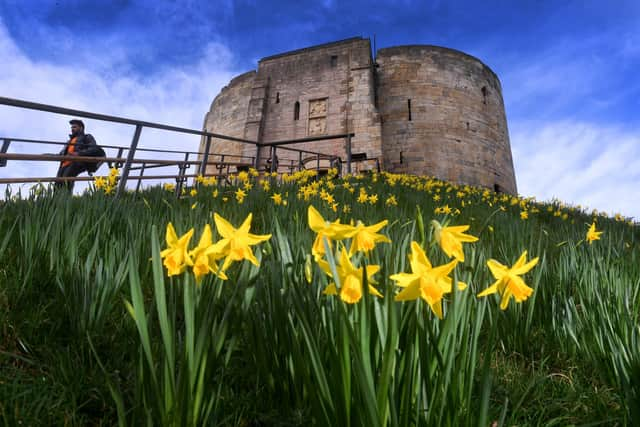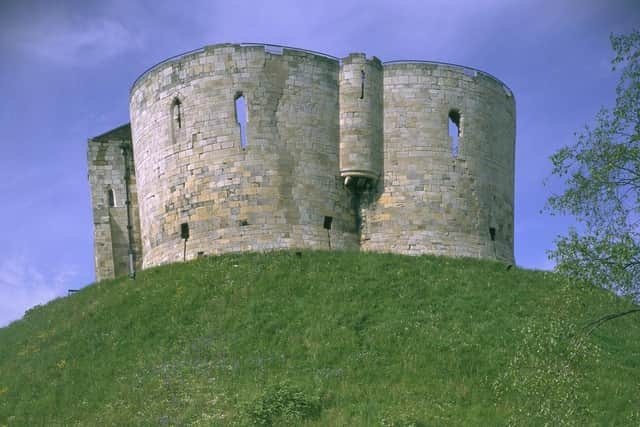Clifford’s Tower: History of York’s most popular landmark and how it has shaped the city’s communities in modern years
Clifford’s Tower is the largest surviving part of York Castle, originally built on the orders of William I and consisted of castles, prisons, law courts and various other state buildings that were built over the last 900 years.
The tower was built on top of an earth mound in the 11th century and was burned down in 1190, following the massacre of York’s Jewish community, when around 150 Jews were besieged by a mob and died by mass suicide.
Advertisement
Hide AdAdvertisement
Hide AdHead historic properties curator at English Heritage, Jeremy Ashbee, has been working within this role for more than 20 years and has become well versed in the history of Clifford’s Tower.


“The Massacre of the York Jewish community in March 1190 is something I’ve been looking at since 2003,” he told The Yorkshire Post.
“When you start reading about the history it’s an event that leaps out at you and obviously I’ve taken an interest in what happened and some of the ideas about why it happened, how it happened and who it happened to.
“It’s an event that is particularly shocking. It reaches out beyond just Jewish history.”
Advertisement
Hide AdAdvertisement
Hide AdEarly history of Clifford’s Tower


The castle of York was founded two years after the Norman Conquest to subdue a rebellion against him which developed into a violent outbreak.
At that time the castle was made out of timber and remained intact through the 12th century until the massacre of 1190, where around 150 Jews were killed.
Clifford’s Tower was built in the mid-13th century as part of a general programme to upgrade the buildings of the castle.
In the beginning of the 14th century, there were severe floods that scoured the earth mound. It was in complete ruins by the 16th century
Advertisement
Hide AdAdvertisement
Hide AdThey added a roof in the 17th century around the of the English Civil War, where they kept guns and a cannon was fired out into the surrounding areas.
In 1684, it is thought that during the firing of a ceremonial salute, a cannon caused a spark to ignite of the military stores in the building including gunpowder and caused an explosion that destroyed the building again.
Clifford’s Tower was enclosed within the grounds of the county jail in the 18th and 19th centuries; the prison and courthouse were the last surviving functions of the castle.
Massacre at Clifford’s Tower in 1190
Following the coronation of King Richard I in September 1189, a riot broke out.
Advertisement
Hide AdAdvertisement
Hide Ad“But people who were hostile towards the Jews apparently threw them out, beat them up, and this turned into a full scale riot in the city of London,” Mr Ashbee said.
The riots reached York on March 16, 1190, and resulted in Jews seeking refuge at the castle where Clifford’s Tower stands.
“Jews went in, men, women and children, and brought as much as they could carry of their own possessions,” Mr Ashbee said.
“They were sparked off by the trust between the Jews and their protectors somehow broke down. But it reached the point at which the Jews have barricaded themselves inside the tower and won’t let anyone else inside.
Advertisement
Hide AdAdvertisement
Hide Ad“That was an immense problem for the officials in the castle because they lost control of one of the most important buildings of the castle and they needed to get it back. At which point the sheriff of Yorkshire called up an army with siege engines and put out a call of anyone in the city of York who could help get the tower back from the Jews.”
The mob climbed up the mound to break into the tower and, according to Mr Ashbee and many other historians, a visiting rabbi from France advised them to take their own lives before the Christians could break in.
“There is a bit of debate around what the motivation was, I think the most obvious, is that they should take their own lives humanely before they were violently butchered by anyone else,” he said.
“But there is another possibility that he was advising them to die as Jews rather than to live under forced conversion to Christianity.”
Advertisement
Hide AdAdvertisement
Hide AdThe tower caught fire and some of the Jews, who were trying to escape, surrendered and agreed to amnesty with the mob.
But when they were outside, the tower collapsed and the mob attacked and killed the remaining survivors.
How has the history of Clifford’s Tower shaped the city of York in modern times?
Throughout York’s modern history, the city has seen communities of all faiths come together in solidarity.
Engagement officer at York Liberal Jewish Community, Lilian Coulson, said: “We are a very inclusive welcoming community.
Advertisement
Hide AdAdvertisement
Hide Ad“We work with Clifford’s Tower, with the city council, with the Archbishop of York, with York Minster and one of my colleagues is very active in York Interfaith Group.
“In York we work together, we stand together, York is a city of sanctuary and that is very much our belief.
“We’ve built up a community from some people who may have had a Jewish heritage, some people are in mixed marriages, where one partner isn’t Jewish. We welcome everybody. We are very much a community of all ages trying to [bring together] Jewish lives in York.
“Our feeling is that you learn from history, you don’t rewrite history, but we all intend to work together in a peaceful way and to respect each other and come out with something that tells the history of York in a way that is accurate that helps make sure we all have a peaceful community moving forward together.”
Advertisement
Hide AdAdvertisement
Hide AdMr Ashbee added: “I believe that this particular story has very powerful lessons for the present day.
“The city of York has done great things in facing up to this sinister part of its history, of taking ownership, not saying it was all a long time ago but actually saying we want a city in which different groups can keep their own identity but live side by side. I think that’s a great thing.”
Comment Guidelines
National World encourages reader discussion on our stories. User feedback, insights and back-and-forth exchanges add a rich layer of context to reporting. Please review our Community Guidelines before commenting.
